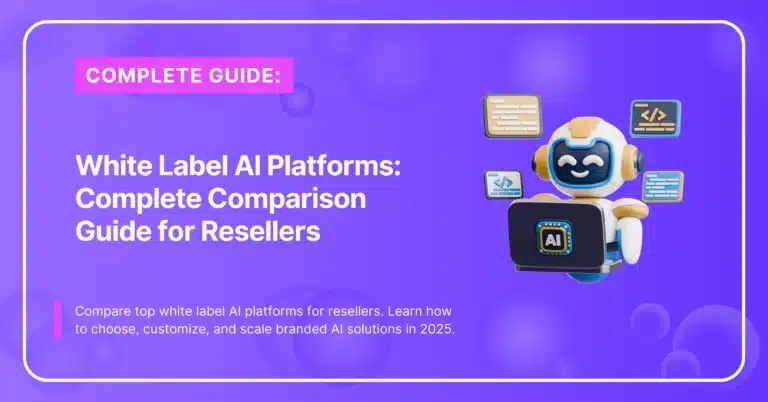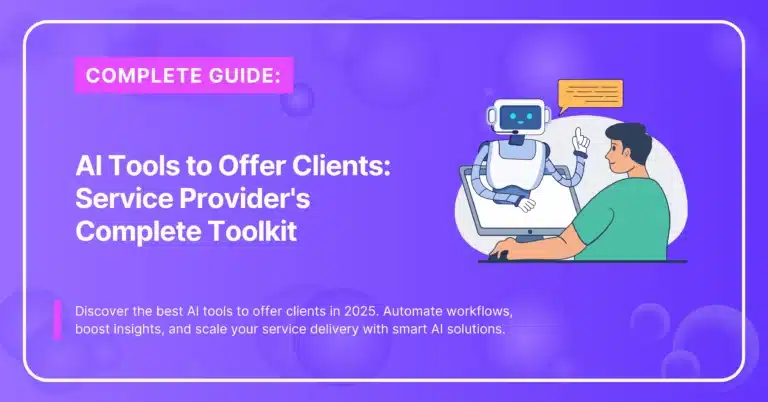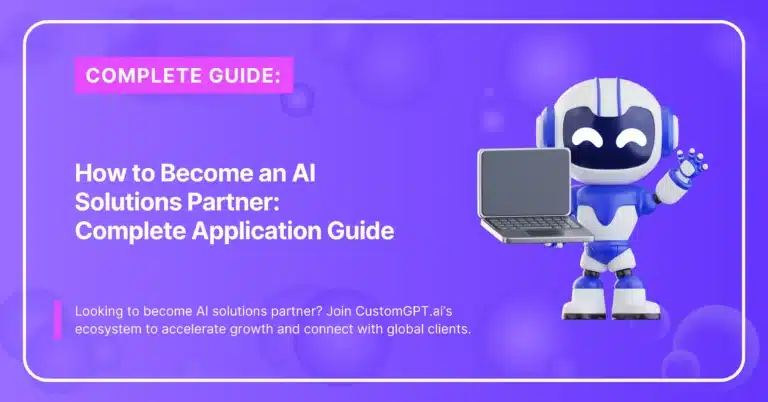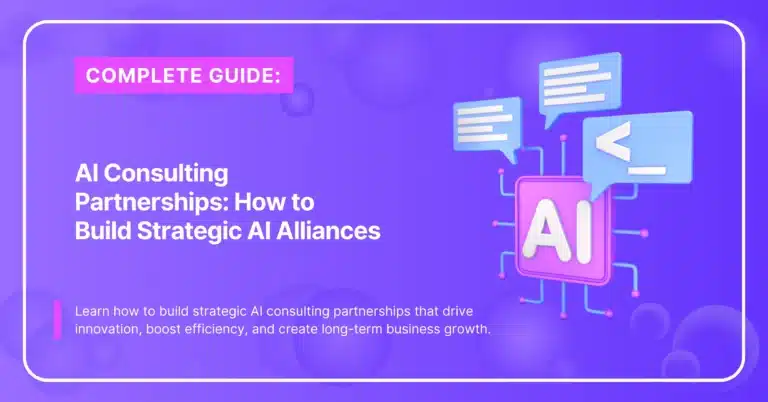Artificial intelligence is no longer a futuristic bullet point on a tech roadmap – it’s the engine quietly reshaping how every modern company wins and keeps customers.
For any IT solution provider assessing platforms, Solution Partner Program offers a fast‑track to resell and white‑label enterprise‑grade AI.

Make Money With AI
Join our Partner Programs!
Boost your reputation, drive revenue and grow your business with CustomGPT.ai.
Yet IT leaders still struggle to choose software that matches both technical roadmaps and business strategy.
For every IT integrator – from managed‑service providers (MSPs) to cloud consultancies – the stakes are high: selecting the wrong platform can stall projects, drain budgets, and erode client trust.
This guide shows you how to spot genuine, enterprise-ready AI solutions amid the hype, ensuring your next rollout delivers real results—minus the pain.
What Makes a Provider AI‑Ready?
An AI‑ready vendor ensures reliable, secure, and scalable deployment across use cases by excelling in six areas:
- Technical maturity & scalable infrastructure: Cloud‑native, containerized foundations with elastic compute, GPU acceleration, and high‑throughput data pipelines.
- Interoperability & open integration: Standards‑based APIs, connectors, and modular micro‑services that snap into ERPs, CRMs, data lakes, and edge devices.
- Adaptive governance & compliance: Embedded policy engines, role‑based access, continuous auditing, and automated monitoring that evolve with GDPR, HIPAA, PCI‑DSS, and more.
- Security by design: Zero‑trust architecture, end‑to‑end encryption, secure SDLC, and real‑time anomaly detection protecting data in motion and at rest.
- Domain expertise & proven outcomes: Cross‑functional AI talent, vertical models, reference architectures, and case studies showing hard ROI.
- Transparent ethics & lifecycle management: Bias testing, explainability dashboards, retraining workflows, and clear documentation of model impact.
A provider that meets these benchmarks turns AI initiatives into lasting business value instead of isolated experiments.
Six Capabilities Every AI‑Ready IT Solution Provider Must Demonstrate
Below are the six capabilities that separate a genuine, scalable AI platform from a clever demo. Each section ends with a practical question you can pose during IT solution provider discussions.
Adaptive Governance & Compliance
A mature platform codifies regulatory intelligence so policy changes propagate through data‑access rules and model workflows without stalling projects or demanding days of manual review.
- Automatic rule updates: keeps your system aligned with new laws without extra work.
- Built‑in policy engine: turns legal text into on/off permissions automatically.
- Instant audit log: tracks every change so you’re always ready for inspection.
- Question to ask: “Can you show how you handled the latest AI law change?”
Scalable, Cloud‑Native Architecture
The infrastructure should pulse in sync with real‑world demand, so capacity never blocks progress and idle GPUs don’t drain budgets.
- Auto‑scaling infrastructure: automatically adds computing power when workloads spike and releases it when things quiet down.
- On‑demand processing power: ramps up in minutes so projects aren’t kept waiting.
- Live usage dashboard: shows in plain numbers how much resource you’re using and what it costs.
- Question to ask: “Can you double the workload right now and show how the live dashboard updates?”
Interoperability & Open APIs
True interoperability lets data and events traverse your landscape in both directions, enabling quick experiments today and painless migrations tomorrow.
- Plug‑and‑play connectors: link quickly to your existing databases and tools.
- Two‑way data flow: shares information back and forth in real time.
- Change alerts: notifies systems when data updates elsewhere.
- Question to ask: “Can you pull a live sample from our current system during the demo?”
Security by Design (Zero‑Trust)
Zero‑trust enforces verification at every hop—from user identity to service‑to‑service calls—so lateral movement is contained and sensitive artefacts stay shielded.
- Two‑step sign‑in: stops password‑only hacks.
- Data locked down: keeps information safe while moving and stored.
- 24/7 threat watch: alerts you if something looks off.
- Question to ask: “Can we see the highlights from your last security test?”
Transparent, Consumption‑Based Pricing
Predictable, usage‑linked pricing turns cost from a guess into a controllable variable, aligning engineering velocity with fiscal discipline.
- Live cost tracker: shows spending as it happens.
- Budget safety switches: warn or pause before overspend.
- Bulk‑use discounts: pay less as you grow.
- Question to ask: “Set a test alert so we can watch it trigger.”
Proven Outcomes and Ethical Guardrails
Readiness ultimately means delivering tangible business wins without compromising transparency or introducing hidden bias.
- Real success stories: clear numbers on money or time saved.
- Fairness checks: spots and fixes bias automatically.
- Clarity reports: explain why the AI made each decision.
- Question to ask: “Show your latest fairness check and the changes made.”
Key Components of AI Readiness
- Natural AI add‑on services: These are ready‑made features—predictive analytics, chatbots, visual inspection, and more—that clip onto the data you already gather. They deliver quick wins without forcing you to rebuild existing systems.
- Transparent consumption‑based costs: With AI, costs rise and fall with usage. A trustworthy IT solution provider shows these numbers live and offers discounts as volume grows, so finance teams stay in control.
- Critical compliance certifications: Badges such as SOC 2 Type II, ISO 27001, HIPAA, or PCI‑DSS prove that third‑party auditors have checked the IT solution provider’s security and privacy practices. Continuous monitoring keeps those badges fresh, shrinking audit headaches.
- Benchmarking AI workload margins: Tracking the cost and profit of each AI job; by project, tenant, or model version, tells you where money leaks. Mature providers hit healthy margins (≈ 70 % on production models, 40–50 % in R&D) and can show you the breakdown.
Strategic Alignment and Business Value
Strategic alignment transforms AI from a technical asset into a business enabler. A 2025 Deloitte study revealed that organizations with tightly aligned AI strategies achieved a 38 % higher ROI than those with fragmented approaches.
Integrating AI into customer service is not merely about automating responses; it is about enhancing customer lifetime value by predicting needs and personalizing interactions.
Amazon’s recommendation engine exemplifies this approach, contributing to a reported 35 % of its annual revenue by aligning predictive analytics with customer-behavior insights.
Achieving alignment demands a robust data-integration architecture that unifies disparate data sources into a centralized platform, enabling AI systems to draw actionable insights.
When AI initiatives are strategically aligned, they optimize operations and unlock new growth avenues, positioning businesses to outpace competitors in an increasingly AI-driven market.
Aligning AI Projects with Business Value
The value-mapping framework systematically links AI capabilities to specific business metrics. In the financial sector, AI-driven fraud-detection systems can be evaluated by their ability to reduce false positives and minimize financial losses.
Cross-functional collaboration is critical. Companies such as Goldman Sachs embed AI teams within business units, fostering a shared understanding of both technical and operational priorities.
AI projects succeed when they are designed to solve real business problems, not just showcase technical prowess.
Technical Preparedness & Infrastructure
A meticulously designed infrastructure is the backbone of any AI-ready software solution. A 2025 Gartner report found that organizations leveraging cloud-native AI infrastructures achieved a 45 % faster deployment rate than those relying on traditional on-premise setups.
Cloud‑Native Foundations
Infrastructure functions as the circulatory system of an AI strategy, if it is clogged or inefficient, the entire operation suffers. Cloud platforms such as AWS and Azure offer elastic compute capabilities, while legacy systems can create bottlenecks if not properly aligned with modern frameworks.
Techniques like API orchestration and data-pipeline optimization ensure smooth data flow and interoperability.
Optimizing Infrastructure for AI Workloads
Intelligent workload orchestration dynamically allocates compute, storage, and networking resources based on real-time demand, minimizing inefficiencies and maximizing performance.
Platforms like Azure Kubernetes Service (AKS) enable containerized AI applications to scale elastically, responding to spikes without over-provisioning.
Dynamic orchestration transforms AI infrastructure from a cost center into a strategic enabler.
Seamless Integration
API wrappers bridge the gap between outdated architectures and modern AI capabilities, extending the functionality of legacy systems without requiring a complete overhaul.
The key to successful integration is designing APIs that not only connect systems but also enhance their operational synergy.
Red Flags That Signal Trouble
- Stale or missing certifications Audit badges (SOC 2, ISO 27001, HIPAA) are older than 12 months or marked “coming soon.”
- Vendor lock-in on model maintenance: Models live in a proprietary format and the support contract excludes export, retraining, or fine-tuning—making you pay extra (or switch providers) to fix drift.
- Always-on compute pricing: You pay the same rate whether GPUs are busy or idle, so unused capacity drains budget.
- Zero transparency on fairness: No bias-detection reports or explainability dashboards to show how the model reached a decision.
- Slow or costly updates: The SLA doesn’t cover rapid security patches, new compliance rules, or version upgrades.
If you see two or more of these red flags, pause the purchase until the provider fixes them.
Partner‑Program Opportunity
For agencies and MSPs eyeing recurring revenue, CustomGPT offers a robust Partner Program that supports:
- White‑label AI deployments, so your brand stays front‑and‑center.
- Turnkey integration for AI Solutions across verticals.
- Training and GTM resources for Agency Partners.
- Revenue‑share tiers that grow with your portfolio.
Browse the full Partner Directory to match real‑world case studies to your clients’ use cases.
FAQ
Which services map naturally to AI add‑ons?
Predictive analytics, recommendations, intelligent search, computer‑vision inspection, and conversational agents extend existing data flows without heavy re‑engineering.
How are consumption‑based costs passed through?
Vendors meter GPU time, tokens, vector reads, and bandwidth, exposing dashboards and tiered discounts so charges follow utilisation.
Which certifications matter (SOC 2, ISO 27001)?
SOC 2 Type II and ISO 27001 are baseline; industries add HIPAA, HITRUST, PCI‑DSS, or ISO 27701, with continuous‑control monitoring for fresh audits.
How do providers benchmark margins on AI workloads?
They allocate GPU depreciation and overhead per model, targeting ≈ 70 % gross margin for mature inference services and 40–50 % during R&D, tracked at tenant and model‑version granularity.
Conclusion
Selecting AI software is less about checking a feature box and more about verifying that the IT solution provider’s entire operating model. The real differentiators are cloud‑native scalability, adaptive governance, zero‑trust security, and a workforce empowered to use AI responsibly.
Evaluate providers against these pillars, map every project to measurable business value, and stress‑test risk controls before you scale.
Follow this checklist and your organization will capture AI’s upside—innovation, efficiency, and revenue—while safeguarding data, budgets, and reputation.
Looking to offer branded chatbot solutions that drive engagement and revenue? Learn more about CustomGPT.ai’s white-label chatbot.





